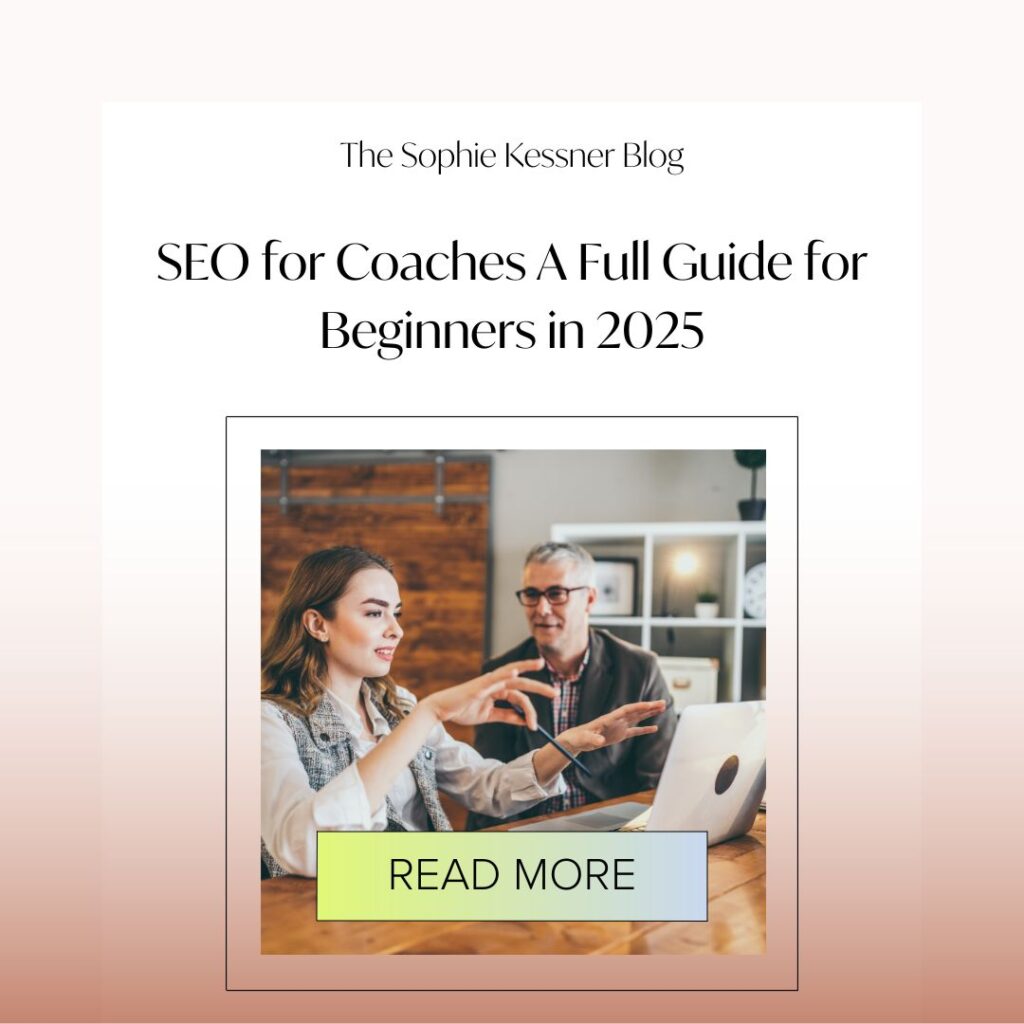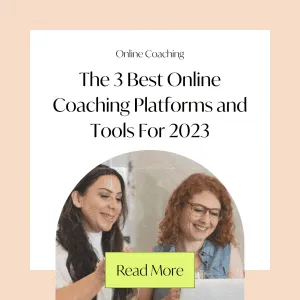Relying on Instagram and Facebook to grow your coaching business? There’s a better way.
Social media can be great for engagement, but it also demands constant content creation just to stay visible. What if you could generate leads without being glued to your phone 24/7? That’s where SEO comes in. Unlike social media, SEO works in the background—bringing in potential clients even while you sleep. And the best part? The coaching industry is still largely untapped when it comes to SEO, meaning there’s huge potential to get ahead of your competitors.
In this guide, I’ll show you how SEO for coaches can unlock passive, long-term growth in 2025, so you can spend less time chasing likes and more time working with clients.
What is SEO for Coaches
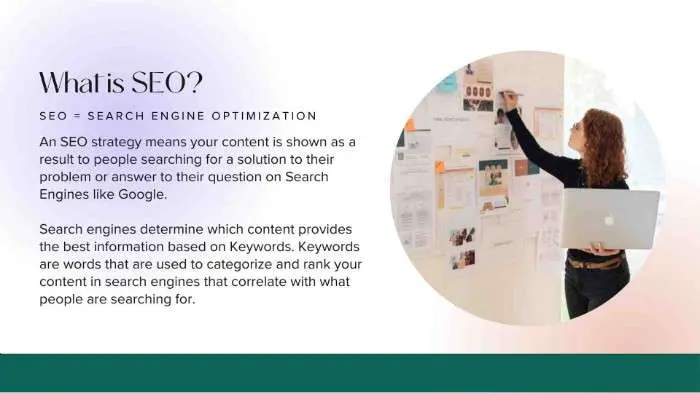
So, what exactly is SEO, and why does it matter for coaches?
SEO (Search Engine Optimization) is the process of improving your website so it ranks higher on search engines like Google. In simple terms, it is all about making your coaching business more visible online—so when potential clients search for your services on Google, they find you instead of your competitors. Unlike social media, where you’re pushing content out, SEO helps you get discovered by people who are already looking for what you offer.
Search engines like Google rank websites based on factors like keywords, metadata, blog formatting, link quality, and referring domains. In simple terms, the better your SEO, the higher you show up in search results—bringing in more organic leads without the constant grind of social media.
Benefits of SEO for Coaches
If you’re a coach looking to grow your business, relying solely on social media can be risky. Algorithms change, trends fade, and what works today might not work tomorrow. That’s why SEO is a game-changer—it gives you a stable, long-term way to attract the right clients without constantly chasing the next big social media trend.
Why SEO is Essential for Coaches
-
Long-Term Visibility – Unlike social media posts that get buried in hours, SEO-optimized content continues to bring in SEO traffic for months or even years. Once you rank for the right keywords, you can generate consistent leads with minimal ongoing effort.
-
More Control Over Your Business – Your website is your digital home, and SEO helps you strengthen it. Social media platforms can restrict your reach or even shut down, but with SEO, you own your content and control its visibility.
-
Higher-Intent Clients – People searching for coaching services online are already looking for solutions. This means they’re more likely to take action—whether that’s booking a discovery call, signing up for your program, or downloading a free resource.
-
A Predictable Lead Generation System – When paired with a strong marketing funnel, SEO can work like a well-oiled machine. Instead of chasing leads, potential clients come to you organically, making your business more sustainable and less reliant on paid ads.
-
Precision Targeting – Through keyword research, you can attract the exact audience you want—whether that’s life coaching clients, executive professionals, or wellness enthusiasts. SEO allows you to meet people at the exact moment they’re searching for your expertise.
-
Cost-Effective Growth – Unlike paid ads that require ongoing spending, SEO is a long-term investment. While it takes time to see results, the payoff is worth it—once your content ranks, it keeps working for you without additional costs.
-
Builds Trust and Credibility – People trust Google and other search engines, and ranking on the first page boosts your credibility. When potential clients see your website constantly appearing in search results, they’re more likely to trust your expertise.
Investing in SEO means building a solid foundation for your coaching business—one that isn’t at the mercy of social media trends. It’s a long-term strategy that keeps bringing in leads, builds authority, and helps you connect with clients who are ready to take action.
How does SEO work?
SEO, or Search Engine Optimization, is how search engines like Google decide which websites show up when someone searches for something online. Think of it as a way to help Google understand that your coaching website is exactly what people are looking for. The better your SEO, the higher you rank, and the more potential clients find you.
Understanding Search Intent
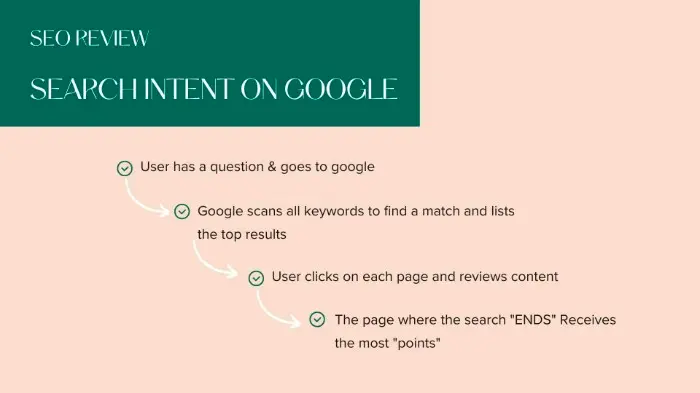
Search intent is a technical SEO term that essentially means what someone is intentionally looking for.
For example, whenever you have a question, curiosity, or want to find information about something, you google it.
Let’s say I was looking for a brand and web design package for my business, I would go to Google and type in “Brand and Web Design Package” then hit “search.”
Google would then crawl the entire internet to see what web page BEST matches my question based on a few variables we’ll talk about down below.
What are Keywords?
The “Keyword” is another important technical SEO term that’s much less complicated than it sounds.
Essentially, the keyword or keywords are the group of words used in the search to find the information.
In this example, our keyword phrase is “brand and web design package”
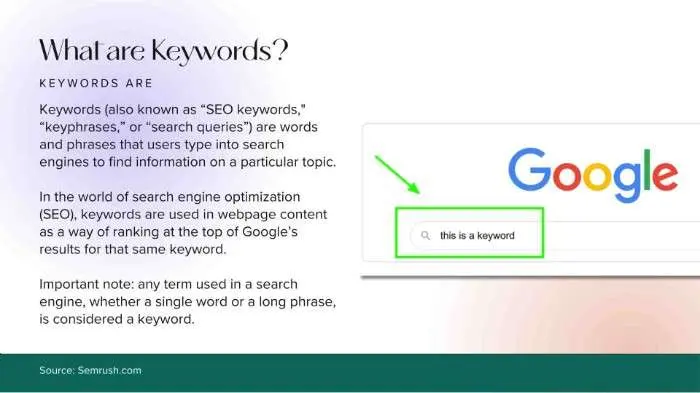
After I search for this keyword, I’ll be sent to the SERP, also known as the Search Engine Results Page which is just a fancy way of saying the first page of Google’s Results but SEO coaches will often refer to it as just the SERP.
You can see an example of the SERP for this keyword search down below.

The SERP is broken into a few important sections with details that are important to understand.
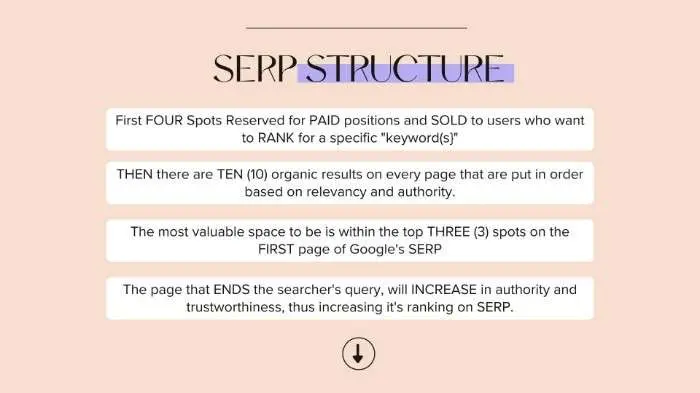
The first 4 spaces on every SERP are reserved for Google Ads
You can see this in the image below or by testing on your own and seeing how the first few options have a “sponsored” text on them letting you know that these sites have paid money to Google to be placed in that spot on the SERP.
After the first 4 spaces, we get into the real magic.
SERP top 10 first page ranking sites
Every SERP on Google will have a total of ten (10) ORGANIC website pages that are currently ranking for the SEO keywords you’ve used in your search.
Traffic breakdown by position on SERP
Based on recent studies from the Advanced Web Rankings from Feb 2025…
The FIRST position on the Google SERP gets more than 41.09% of all clicks from the organic search.
The second position gets 14.15% while the third position gets 8.89% and the fourth position gets 5.3%
That means more than 50% of ALL the traffic from this search or any search on Google goes directly to the first 4 pages on the Google SERP.
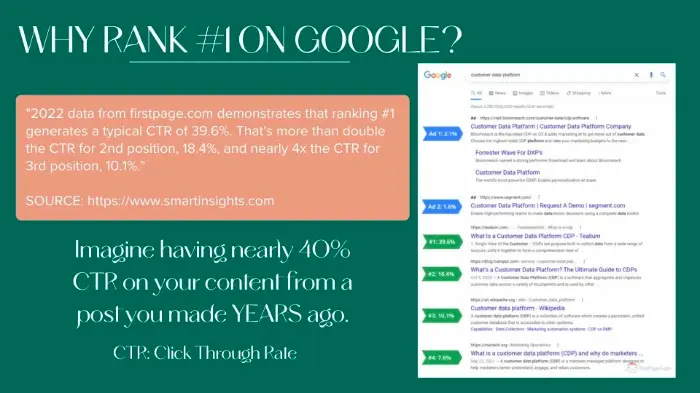
Okay but why does this matter?
Another technical SEO term any good SEO coach will teach you has to do with “Search Volume” so let’s take our example from above and continue to break it down.
Based on the previous example we’ve been using throughout this article, we can see through Ahrefs research that this single blog post, Google is sending this page more than 800+ site visitors every single month allowing it to rank for.
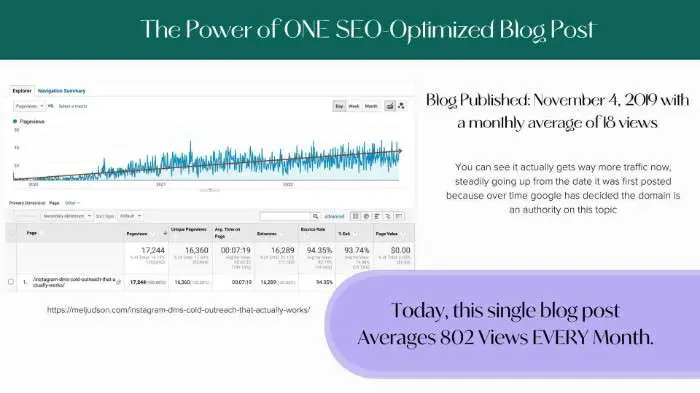
This blog post was originally written in November of 2019 with an average monthly view of 18 site visitors. However, it has continued to compound and start ranking for the keywords, allowing it to become an easy sales funnel to attract new clients without constantly posting online.
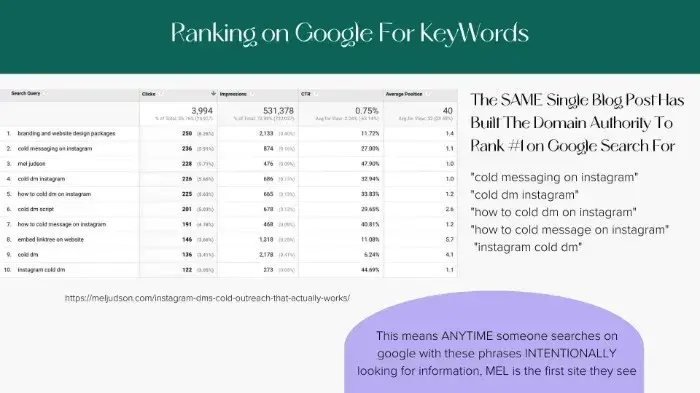
Imagine if ONE Instagram or Facebook post you wrote FOUR years ago was STILL bringing you 800+ new leads every month and growing for even more Keywords!
Sophie Kessner
How to Do Keyword Research for Coaches
Keyword research is the foundation of a successful SEO strategy. It helps you understand what your ideal clients are searching for and how you can position yourself as the go-to expert in your coaching niche. Let’s break it down step by step.
First, keywords are the words and phrases people type into Google when looking for information. As a coach, ranking for the right keywords ensures that your website appears in front of the right audience. But not all keywords are created equal—some bring traffic, while others bring actual paying clients.
This is why search intent matters. Are people looking for general information, or are they ready to invest in coaching? Keywords like “how to improve self-confidence” indicate someone is in the research phase, while “best life coach in San Diego” suggests they’re ready to hire.
Different Types of Keywords to Consider:
-
Short-tail keywords (e.g., “life coaching”) – Broad but highly competitive.
-
Medium-tail keywords (e.g., “life coaching for professionals”) – More specific, lower competition.
-
Long-tail keywords (e.g., “best confidence coach for women in San Diego”) – Highly specific and conversion-focused.
-
Informational keywords (e.g., “how to overcome self-doubt”) – Attract readers looking for advice.
-
Navigational keywords (e.g., “Tony Robbins coaching program”) – Show intent to find a specific brand or service.
-
Transactional keywords (e.g., “hire a mindset coach near me”) – Indicate a strong buying intent.
-
Local keywords (e.g., “business coach in San Diego”) – Help attract nearby clients.
How to Find the Right Keywords
Use tools like:
-
Google Keyword Planner (Free, great for basic research)
-
AI-powered tools (Like Chat GPT, for brainstorming keyword ideas based on client questions)
Look for a mix of high-traffic keywords and buyer-intent keywords. Prioritizing niche-specific keywords helps attract high-end clients. Instead of just “career coach,” try “career coach for mid-level managers in tech.”
By focusing on strategic keywords, you’ll drive targeted traffic to your coaching website and convert visitors into paying clients with ease.
How does Google Rank First Page Search Results?
In order to understand HOW to rank on Google, you need to know WHAT you’re trying to rank for and who your ideal clients are and how you can leverage seo coaching for creatives or any other business owner.
Because Google is an INBOUND marketing method, you have to know what your ideal clients are searching for and find keywords that you can use to create free resources (like this blog post) to build up your website content for your target audience.
Google uses a fancy tool called “spiders” that essentially “crawl the web” to read all of the content that exists on every page of every site that’s ever been created and index pages based on the content that’s on them.
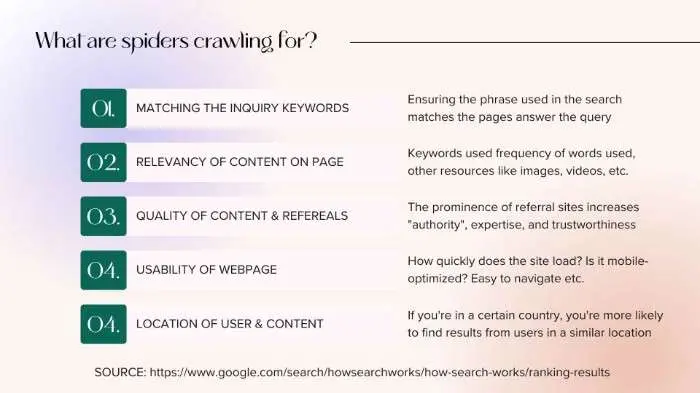
“Spiders” are crawling for a few important pieces of information including SEO keywords that match the search intent both on the page itself but also in the meta description, title, URL and more.
Relevancy and Quality
It will prioritize pages that most closely match the keywords THEN look at the relevancy and the quality of the actual content on the page, which is why it’s crucial to know who your ideal clients are and understand that SEO isn’t just about stuffing words onto a page, but to ensure that the person looking for the information finds what they need.
Ending The Query
This is known as “ending the search query” which is just another fancy SEO coach term to say that the user looking for something on Google FOUND what they needed and are no longer searching.
If someone clicks over to a page that doesn’t have the answer they’re looking for and leaves the page to go back to Google to explore other websites ranking on the SERP and find the information they need on that page.
This is an important and valuable action that tells Google the quality of this page is better.
Site Speed
Google also bases SERP ranking on the site speed and user-friendliness of the site. Meaning how quickly the site loads, if it is mobile optimized, and if it is easy to read and navigate throughout the content.
Local SEO
Finally, Google will also base results on local SEO which means they will present information that is in the same relevant geographical location as the person who is searching for it and the person who created the content.
For example, if I search for something in San Francisco, California, I am likely to find results based in California or surrounding areas.
This is why any marketing coach or SEO coach needs to ensure you’re also leveraging local SEO into your marketing strategy, especially if you have a physical brick-and-mortar business or see clients in person.
Link Building
Finally, Google is also looking at the external links and internal links on your site and pages to see how much credibility and authority your site has built.
If you have websites like Forbes.com linking to your coaching website, it tells Google that your coaching website is more trustworthy because another site with high credibility is referencing you;
To improve your chances of having your own website or sales pages rank #1 on the Google SERP is to build links that are high quality both within your site and from other sites.
If you’re not sure where to start, I recommend finding an SEO coach who specializes in your niche, we offer a free SEO training for coaches and course creators in the health coaching space, you can learn more about it here.
How is SEO different from other social media strategies?
To understand HOW SEO works, it’s important to understand the terms attention merchant business model and the way social media platforms like TikTok, Instagram, and Facebook build out their algorithms which tend to be very different from any SEO industry and focus primarily on Interruption and Disruption.
The Attention Merchant Business Model
Platforms like Instagram, TikTok and Facebook use a very specific business model that relies on getting and keeping users attention for as long as possible.
The longer that users are on the platforms, the more data these platforms have to resell to business owners who want to buy ad space on their platforms.
The better results business owners get with ads from more accurate targeting, the more money they invest in ads with the platform, boosting the platform’s revenue.
I wrote a full blog outlining the Attention Merchant Business Model here for you to read about in more detail.
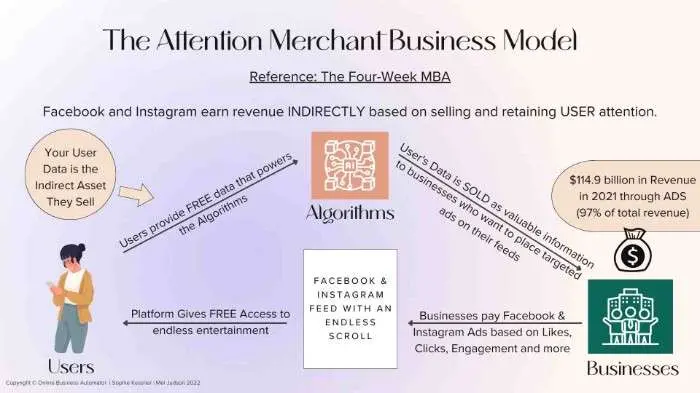
The core difference between Social Media and SEO is broken into three categories:
-
How information is found
-
How long content can continue to be easily found
-
The goal of the platform
The goal of Search Engines is to simply, end the search query as fast as possible.
Whereas the goal of social media platforms based on the Attention Merchant Business Model is to keep users on the platform as long as possible to collect as much data as possible.
Life Span of the content
Based on recent studies, the average social media post lasts anywhere from 30 minutes to 40 hours, not including YouTube.
Platforms like TikTok, Instagram, and Facebook do not have search engines built into them and don’t leverage keyword research, which is why the lifespan of these platforms’ content is so short.
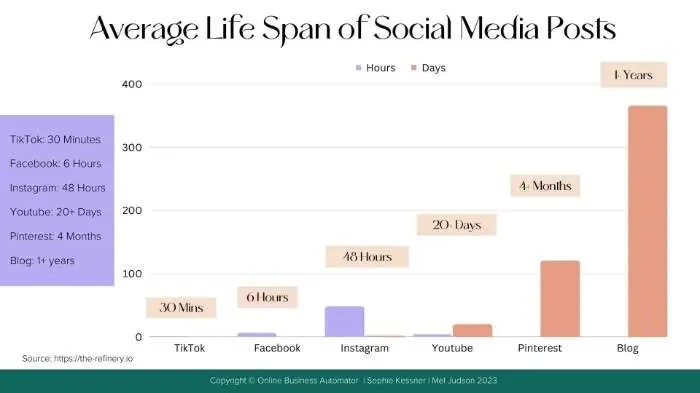
After the prime time expires, if your piece of content hasn’t gone viral, it disappears into the social media blackhole of content never to be seen again while you are forced to continue producing more and more content fighting for attention with every other creator on these platforms.
To continue being seen by potential coaching clients, and driving website visitors to your business, you have to continue becoming more creative with your content to interrupt and disrupt someone’s scroll to get them to pay attention to you.
If you are a health coach or a nutrition coach or any other type of wellness practitioner, chances are you have a highly valuable skill with years of knowledge that your coaching clients need and want to find.
But without the right strategy or knowing what specific keywords to use in your content, it can feel incredibly overwhelming.
The Difference Between Inbound and Outbound Marketing
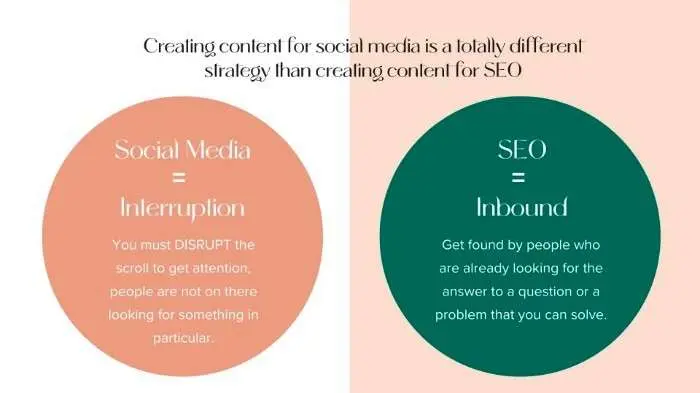
Inbound marketing refers to strategies that focus on getting potential customers to find you through organic SERP rankings.
This often includes activities like blogging, link-building, and keyword research.
Interruption marketing is the purpose of all major social media platforms that focus on distracting and grabbing attention through engaging content.
There is no way to directly target keyword research with outbound marketing unless you’re intentionally leveraging paid ads on these platforms.
How to find the right strategy to create content with SEO
The goal of Search engines is to bring you more website visitors and improve your overall SEO results by leveraging your understanding of your target audience and consistently creating high-value content that ranks on the Google SERP.
But free website traffic is just the beginning!
The most strategic SEO coaching is one that combines the knowledge of search engines with a very valuable skill in email marketing that turns your website visitors into email list subscribers.
One of the core funnels you’ll want to have in place that we teach clients in a single coaching session is the ability to have a high-converting opt-in funnel.
We share more about the best platforms for online coaches to run their businesses all in one place here.
These practices include optimizing the page titles, meta descriptions, content structure, and images for relevant keywords. Additionally, on-page SEO also includes ensuring that each page has a clear call-to-action (CTA) that encourages visitors to take action on your site.
By taking the time to implement effective on-page SEO practices, you can increase your website’s visibility in SERPs and drive more targeted traffic to your coaching business.
When it comes to measuring success with SEO, there are several metrics you can track such as organic traffic, keyword rankings, conversion rates, and more.
Creating an SEO-Friendly Website for Your Coaching Business
In today’s digital age, having a strong online presence has become a vital aspect of running a successful coaching business. One key element to achieving this is by creating an SEO-friendly website by utilizing SEO Copywriting by learning from SEO educators like myself and business partner, Mel Judson or big name SEO professionals with free SEO courses like Neil Patel.
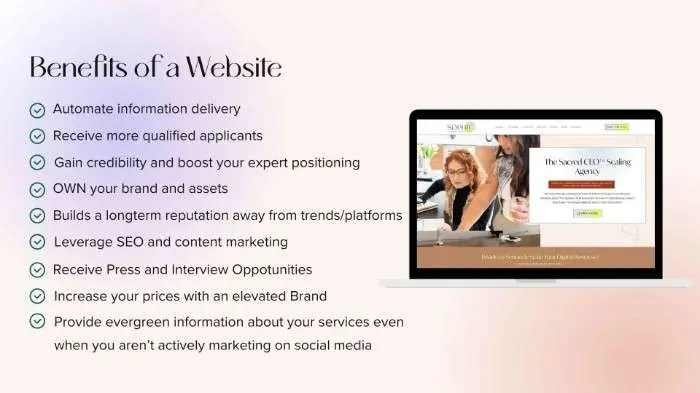
SEO Coaching is a process of optimizing your website to rank higher in search engines such as Google through SEO optimized marketing strategies
By doing so, potential clients are more likely to find your website and ultimately, your coaching services.
Optimizing for SEO involves various strategies, including choosing relevant keywords, creating high-quality content, and ensuring your website is mobile-friendly- below is an outline of the anatomy of a website that converts:
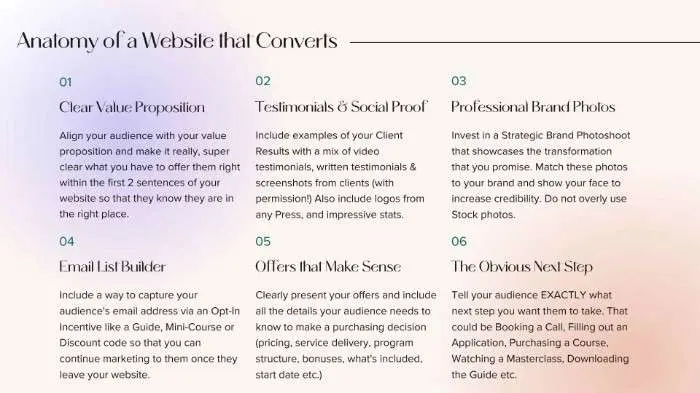
You can checkout the Website SEO Analyzer tool to help improve your website SEO ranking
Optimizing Content For SEO
If you’re looking to increase traffic to your website, optimizing your content for SEO is a must. But what exactly does that mean? Essentially, it involves structuring and writing your content in a way that search engines can easily crawl and understand while also keeping it engaging for your audience.
Create High-Quality, Valuable Content
Search engines prioritize content that provides real value to users. This means your content should be:
-
Unique and comprehensive – Cover topics thoroughly and provide insights that set you apart from competitors.
-
Matching search intent – Understand what your audience is looking for and ensure your content directly answers their questions.
-
Long-form and in-depth – Aim for at least 1,500 words when possible. Longer content tends to perform better in search rankings as it signals depth and authority.
Enhance Content with Engaging Elements
High-ranking content isn’t just about words—it’s about engagement. Consider enriching your pages with:
-
Expert quotes and case studies – This builds credibility and trust with your readers.
-
Videos and images – Multimedia elements make your content more engaging and improve dwell time.
-
User engagement signals – Encourage comments, shares, and interactions to show search engines that your content is valuable.
Types of Content Coaches Should Focus On
Not all content is created equal. As a coach, your website should include:
-
Blog posts – Educational content that answers common questions and builds trust with potential clients.
-
Service or specialty pages – Clearly outline your coaching services and their benefits.
-
Sales pages – Optimized pages designed to convert visitors into paying clients.
On-Page SEO: Optimizing Existing Content
Once you have strong content, fine-tune it with on-page SEO strategies:
-
Strategic keyword placement – Naturally integrate keywords into headings, subheadings, and throughout the content.
-
Clear and compelling title tags & meta descriptions – These influence click-through rates from search results.
-
Internal and external linking – Link to relevant pages on your site and authoritative sources.
-
Well-structured formatting – Use short paragraphs, bullet points, and headers to make content easy to read.
-
Optimized images – Add alt text and compress images to improve page speed.
By focusing on these content optimization strategies, you’ll create a website that not only ranks well but also resonates with your audience. SEO is a long-term game, but the effort you put in today will pay off with increased visibility and client engagement.
Using Links to Increase Search Rankings
Links play a huge role in SEO, acting as pathways that connect different pages on the web. The more quality links pointing to your site, the more search engines see your content as valuable and trustworthy. But not all links are equal—Google is smart enough to spot spammy or low-quality links and won’t hesitate to ignore them.
There are two main types of links to focus on:
-
Internal links – Links that connect pages within your own website, helping users navigate and search engines understand your site structure.
-
External links – Links that connect your website to other websites, either as sources or references.
Then there are backlinks, which are a specific type of external link—but in reverse. Instead of you linking out, a backlink is when another website links to your content. Backlinks are crucial for SEO because they act as endorsements, signaling to search engines that your site is credible and worth ranking higher.
When it comes to backlinks, quality matters more than quantity. A single link from a well-known industry site is far more valuable than dozens of random links from low-quality sources. Here are a few ways to earn strong backlinks:
-
Create valuable content – Share insights, research, or unique perspectives that others want to link to.
-
Guest blogging – Write articles for reputable websites in your niche and include a link back to your site.
-
Leverage relationships – Connect with other coaches, bloggers, and industry professionals who might be willing to mention or link to your content.
-
Participate in relevant directories – List your business on well-respected coaching directories and professional networks.
You might also hear about dofollow and nofollow links. Dofollow links pass SEO value (helping your rankings), while nofollow links tell search engines not to pass ranking credit. While dofollow links are the goal, nofollow links can still drive traffic and brand visibility.
At the end of the day, link building is about creating genuine connections and providing value. Prioritize quality over quantity, and over time, your coaching business will gain the authority and trust needed to rank higher in search results.
Best Technical SEO Practices for Coaches
Technical SEO keeps your website fast, secure, and easy to find. If search engines can’t crawl your site or visitors leave due to slow speed or poor navigation, you could be missing out on potential clients.
The good news? A few simple tweaks—like improving speed, security, and structure—can make a big difference. Let’s break it down.
1. Site Speed
A slow website frustrates visitors and lowers your ranking. Use Google PageSpeed Insights to test your site’s speed and make improvements, like compressing images and enabling caching.
2. Mobile-Friendliness
Most people browse on their phones, so your site needs to look and function well on all devices. A mobile-friendly design improves user experience and helps search engines rank your site higher.
3. Website Security (HTTPS)
An HTTPS connection secures your site and builds trust with visitors. Google also favors secure sites in search rankings, so get an SSL certificate to protect user data and improve SEO.
4. Broken Links
Broken links frustrate visitors and make your site look outdated. Use tools like Screaming Frog or Google Search Console to find and fix them with 301 redirects, ensuring a smooth user experience.
5. Site Architecture
A clear site structure makes navigation easy for both users and search engines. Keep your menus simple, use descriptive URLs, and create an XML sitemap to help search engines index your pages efficiently.
6. Domain
Having a keyword in your domain can give a small SEO boost, but branding is just as important. Choose a professional, easy-to-remember domain with a trusted top-level extension (.com) and ensure it’s secured with HTTPS.
By optimizing these areas, your coaching website will be faster, safer, and more visible to potential clients.
Tracking and Measuring Results From SEO Efforts
Tracking your SEO performance isn’t just about checking rankings—it’s about understanding what’s working, what’s not, and how to improve. By keeping an eye on key metrics, you can see how your content attracts visitors, converts leads, and impacts your business growth.
Some of the most important KPIs to track include:
-
Organic traffic: The number of visitors coming to your site through search engines. Google Analytics can show you where your traffic is coming from and how users interact with your pages.
-
Keyword rankings: See where your website appears in search results for targeted keywords. Tools like Google Search Console or third-party platforms can help track your ranking progress over time.
-
Lead generation from organic traffic: How many inquiries, sign-ups, or bookings come directly from search engines? This tells you whether your SEO efforts are bringing in potential clients.
-
Conversion rates: The percentage of visitors who take a desired action, whether that’s filling out a form, scheduling a consultation, or making a purchase.
-
Search volume & traffic potential: Understanding how often a keyword is searched and its potential to bring traffic helps in content strategy and prioritization.
-
Keyword Difficulty (KD) & Cost Per Click (CPC): KD tells you how hard it is to rank for a keyword, while CPC gives insight into how valuable that keyword is for paid ads. Both metrics help in choosing the right SEO opportunities.
Using tools like Google Analytics and Google Search Console makes it easier to track these KPIs and adjust your strategy when needed. The more you monitor and refine your SEO efforts, the better results you’ll see in the long run.

Favorite SEO Tools
If you’re wanting to take your SEO strategy to the next level, we want to share a few of our favorite tools to help you speed up the process of improving your search engine rankings. Below are a few of the top tools we recommend for SEO marketing:
Jasper.Ai
Jasper AI is the king of AI copywriting softwares and has a direct plugin with Surfer SEO that allows you to have a robot write high quality SEO content for you that’s bound to rank on search engines with the right strategy and keyword research.
You can try Jasper.AI for free by clicking here.
Surfer SEO
Surfer SEO is the BEST platform for writing your SEO optimized blogs and content with advanced tools to help you plan out your content strategy and pulls from search engines in real time.
You can try Surfer SEO by clicking here.
Ahrefs
If you’re serious about SEO for your coaching business, there’s no other software that compares to what Ahrefs has to offer but it’s recommended to go through SEO coaching with and SEO expert first before trying to jump into the complexity of Ahrefs.
Ahrefs has a free plan that you can get started with here.
Ubbersuggest
A more affordable alternative to Ahrefs is Ubbersuggest created by one of the Top SEO Coaching experts in the SEO industry, Neil Patel.
This platform offers a free option along with a low cost $29/month plan that you can sign up for here.
SEO Coaching Session with Soph
If you’d like to have a more personalized coaching session where we can do an actual audit via a shared screen session of your current site and assets, you can get in touch via the contact page on this site to inquire about an SEO Coaching session by clicking here.
SEO Training
You can explore our free Scaling Without Social Media Workshop to learn the basics of SEO Marketing and how to apply it to your business by clicking here.
Conclusion
All in all, SEO is an effective tool for coaches to use in order to grow their coaching businesses in any given year, but especially so by 2025.
Coaches should put time into researching and understanding keywords, creating a website and content that caters to SEO practices, utilizing links as part of their marketing efforts, and tracking their progress with various tools.
By optimizing their coaching business for search engines, coaches can tap into a massive pool of potential clients that are already looking for them.
Therefore, using SEO now is essential in helping your coaching business thrive in the future.
Ready to attract more clients and grow your coaching business? Sass and SEO takes the hassle out of SEO with tailored strategies that get real results. Start optimizing today and see the difference!
For our full guide on tools to scale your coaching business in 2025, check out full blog here:
Please note certain links throughout this blog may have affiliate commissions.

